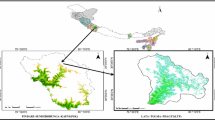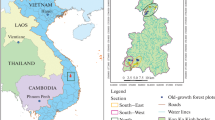Summary
This paper deals with one aspect of an architectural study of different phases in secondary vegetation. An investigation has been carried out on the abandoned fields of one Indian tribe of French Guiana. This study is largely based upon the theory of forest architecture by R.A.A. Oldeman (1974). A short revue of the most important concepts of this theory is presented, such as ‘initial model’, ‘reiteration’, ‘set of the present, of the future and of the past’, ‘structural ensemble’ and ‘inversion surface’. Moreover, different stages of the architecture of vegetation, 2 1/2, 3 1/2, 4, 11, 23, and 33 years old have been described with help of diagrams, as well as two aspects of primary forest situated in the vicinity of secondary vegetation. Finally, a variation of a few measurable parameters through a period of time has been analyzed and conclusions drawn about the observed succession of architectural phases.
Résumé
L'auteur étudie l'architecture de differentes phases de la régénération forestière observée en Guyane française sur d'anciens essarts de l'une des tribus amérindienne du pays. Cette étude qui se fonde sur la théorie de l'architecture forestière que l'on doit à Oldeman (1974) en résume tout d'abord les principaux concepts. Puis l'architecture est étudiée sur differentes parcelles où la végétation est agée de 2 1/2, 3 1/2, 4, 11, 23 et 33 ans, ainsi que sur deux parcelles de forêt primaire proches des anciens essarts étudiés. L'auteur décrit enfin les variations, au cours de la régénération, de quelques paramètres mesurés et dégagés par l'étude de l'architecture; il décrit ainsi des phases architecturales de la régénération.
Resúmen
El sujeto de esta comunicación es un aspecto del estudio bioarquitectural de las distintas fases de la vegetación secundaria. Las investigaciones de campo han sido efectuadas en las chacras abandonadas de una tribu indígena de la Guyana francesa, la de los Wayãpi. El análisis se apova en la teoría de la bioarquitectural del bosque, publicada por Oldeman en 1974, y comienza defimiendo algunas de las nociones más importantes de este método, tal como el ‘modelo inicial’, la ‘reiteración’, los ‘conjuntos del presente, del futuro y del pasado’. Además, han sido presentados varias fases bioarquitecturales del bosque secundario respectivamente de 2 1/2, 3 1/2, 4, 11, 23 y 33 años de edad, y también, dos aspectos de selva primaria ubicada en la vecindad del bosque secundario. El método de representación gráfica se sirve de diagramas esquemáticos. Por fîn, han sido analizados algunos parámetros mesurables durante un peiodo de tiempo. Las conclusiones incluyen los caracteristicos del proceso de succesión que se observó a través de sus fases bioarquitecturales.
Thanks are also due to my Wayãpi assistants in the fields, R. Yawalu and R. Alasuka.
Similar content being viewed by others
References
Halle, F. & R.A.A. Oldeman. 1970. Essai sur l'architecture et la dynamique de croissance des arbres tropicaux. Masson, Paris, 178 pp.
Oldeman, R.A.A. 1974. L'architecture de la forêt guyanaise. Mémoire O.R.S.T.O.M. no. 73. ORSTOM, Paris.
Author information
Authors and Affiliations
Additional information
Contribution to the 4th symposium of Tropical Ecology, 7–11 March 1977, Panama.
Thanks are due to Dr. H. Lieth for extensive editorial work on this manuscript.
Rights and permissions
About this article
Cite this article
Lescure, J.P. An architectural study of the vegetation's regeneration in French Guiana. Vegetatio 37, 53–60 (1978). https://doi.org/10.1007/BF00117268
Accepted:
Issue Date:
DOI: https://doi.org/10.1007/BF00117268




